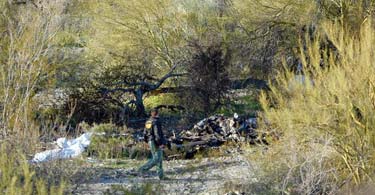BY LINDA BENTLEY | NOVEMBER 14, 2012
NTSB says five year old probably caused 2010 Eurocopter crash
Contributing to the accident was absence of proper cockpit discipline from the pilot’
 The National Traffic Safety Board has issued its findings in the Feb. 14, 2010 fatal Eurocopter EC135 crash in Cave Creek, in which all five people and two dogs on board perished, and says it may have been caused by a five year old inadvertently kicking flight controls while sitting on her father’s lap.
Courtesy photo
The National Traffic Safety Board has issued its findings in the Feb. 14, 2010 fatal Eurocopter EC135 crash in Cave Creek, in which all five people and two dogs on board perished, and says it may have been caused by a five year old inadvertently kicking flight controls while sitting on her father’s lap.
Courtesy photo
CAVE CREEK – After nearly than two and a half years, the National Traffic Safety Board (NTSB) has issued its findings and probable cause of the Eurocopter EC135 T1 that crashed in a wash near 72nd Street and Highland Road in Cave Creek on Feb. 14, 2010, killing all of its occupants.
An area resident who witnessed the crash described the scene as “horrific” with body parts strewn everywhere just prior to the aircraft bursting into flames.
According to the NTSB report, “The accident was not survivable.”
The helicopter was registered to Services Group of America (SGA).
SGA founder and owner Thomas J. Stewart, 64, his wife Madena, 40, her brother, Malang Abudula, 38, and the Stewarts’ five-year-old daughter were killed in the crash along with company pilot Rick Morton, 63, and the Stewarts’ two dogs.
The helicopter was en route from the Stewarts’ ranch in Parks, Ariz. to the Scottsdale Airport, a trip the Stewarts made frequently.
According to the NTSB’s brief of the accident adopted on Nov. 7, 2012, a significant amount of investigative work was conducted, incorporating data from various sources.
The report states a ranch foreman observed the flight preparations and saw Stewart board the helicopter and occupy the left cockpit seat. He then saw Stewart’s daughter board the helicopter and sit on her father’s lap.
The pilot, it notes, had accumulated 11,045 hours of total flight time, all in rotorcraft-helicopters, 824 hours of which were in the EC135 T1, was already seated in the front right cockpit seat.
Both left and right cockpit seats were equipped with dual flight controls and, according to operator personnel, Stewart’s daughter sat on her father’s lap occasionally during flights, Stewart liked to fly the helicopter and it was common for him to fly.
Although Stewart was certified to fly airplanes, single-engine land, he was not a rated helicopter pilot.
Thirty-five minutes after the helicopter departed the ranch it approached an area about 1 nautical mile north of the accident site. Radar data indicated it was flying at about 2,000 feet above ground level.
Witnesses on the ground stated they heard unusual popping or banging noises and several said they saw parts separate from the aircraft before it circled and dove to the ground.
The helicopter landed in a wash “slightly nose-down and slightly left-bank attitude” before it was ultimately consumed by a post-crash fire.
In the post-accident examination of the helicopter, the investigators determined no pre-impact failures or material anomalies were found in the wreckage and the cause of the yellow blade intersecting the tail rotor drive shaft was most likely an abrupt and unusual control input.
During flight simulation, the report cites the only way that particular condition could have occurred “was as a result of a sudden lowering of the collective to near the lower stop, followed by a simultaneous reaction of nearly full-up collective and near full-aft cyclic control inputs,” and states, “A helicopter pilot would not intentionally make such control movements.”
The biomechanical study of the accident determined it was highly likely that Stewart’s daughter, while sitting on her father’s lap, could have inadvertently stepped on the collective with her left foot and displaced it to the full down position. That condition would have resulted in either Morton or Stewart raising the collective, followed by a full-aft input pull of the cyclic control and subsequent main rotor departing the normal plane of rotation and striking the left endplate and the aft end of the tail rotor drive shaft.
Even more disturbing, the investigation revealed Morton had been involved in two prior incidents (May 2003 and June 2004) while operating the same helicopter without reporting the incidents to the Federal Aviation Administration.
On May 8, 2003, it noted Stewart was operating the aircraft and his seat slid back while on final approach to landing. As a result, the helicopter dropped about 50 feet before impacting terrain, causing damage to the horizontal stabilizer.
The NTSB stated Morton failed to use proper cockpit discipline when he allowed Stewart, who was not rated for helicopters, to operate the helicopter’s controls, particularly during a critical phase of the flight.
Additionally, an instructor pilot, who conducted recurrent training for Morton, reported, during a conversation with him, Morton commented about how Stewart would dominate the cockpit duties and said Stewart would “get in the helicopter, flip the switches and go.”
The investigation was unable to determine who was flying the helicopter at the time of the accident but also stated it was not relevant to the cause of the accident.
However, the brief pointed out the previous incidents, the statement by Morton that Stewart dominated cockpit duties, and Morton allowing Stewart’s daughter to sit on her father’s lap during flight all indicated Morton did not maintain strong cockpit discipline, which the NTSB said contributed to the accident.





